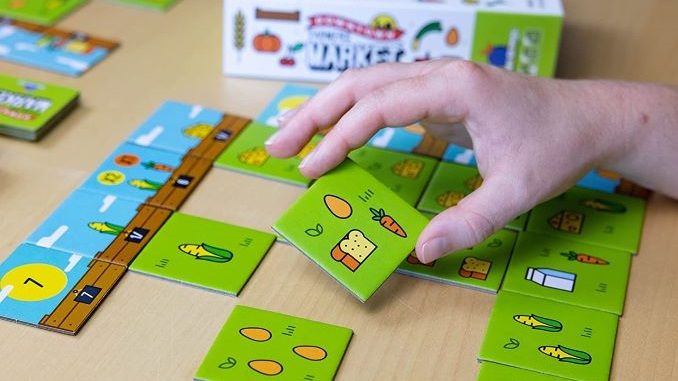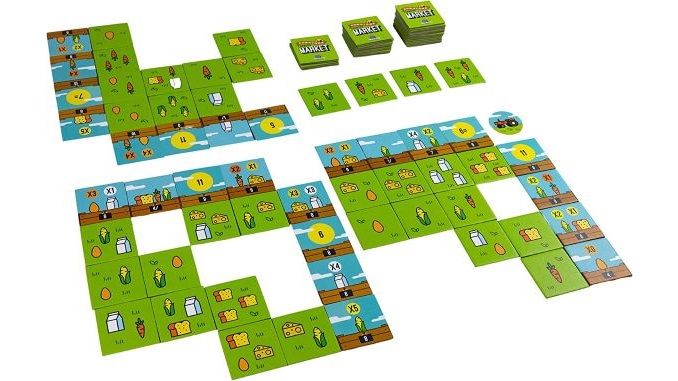
Downtown Farmers Market is a deceptive little game, coming in a cute (and very well designed) box with pop artwork depicting the various goods you’ll try to collect—or avoid—over the course of the quick playing time. While the rules are easy to grasp, the way it plays out gives you a difficult puzzle to solve with a lot of variables to keep in your head, both to maximize your score and to avoid boxing yourself into a corner by the time the last turn or two roll around.
The concept behind Downtown Farmers Market is that you’re all going shopping and have certain criteria for what goods you’re bringing home. There are six types, and they’re depicted on the game’s 65 food tiles in all sorts of combinations, from a single good on a tile to three goods that might all be the same or all different or have two of one sort and one of a third. In every round, there will be five tiles available in the center of the table, and each player will get to choose one and place it in front of them, creating a 4×4 grid as the game goes along.
The catch is that your grid is bounded by eight tiles, four along the top and four along the left side, that reward you points based on what is in the column or row connected to that tile. That might be as simple as giving you one point for every carrot or corn icon that appears in the row, or as specific as requiring that you have 11 total goods of any types in the column, or as constraining as requiring that you have no milk, eggs, or bread in the row (the French toast penalty, it seems). Early in the game, it’s easy to find a useful tile among the selections left for you on the table, but as the game progresses you will find that some tiles become unplayable for you unless you’re willing to give up on scoring one of your eight border tiles completely.

You have very little choice in those scoring tiles, which the game refers to as Category tiles, a name I don’t find particularly apt to their role. You get four for the top row of your grid and can choose the easier or harder side of each, as well as deciding the order in which to place them, but that’s it. Then you get four more for the left column and you do the same thing. You get the eight tiles you get, and you don’t get upset.
With four players, the game plays exactly as I’ve described, while there are some small tweaks for two or three players to ensure that all food tiles appear over the course of play. With two players, the first player in a round takes one tile from the five on the table, then discards one; the other player then does the same. (The fifth tile always remains for the next round, regardless of player count.) With three players, only the first player in the round takes the discard action. That adds a competitive element, where you should at least glance at your opponents’ grids to try to discard a tile they need, that’s absent with four players. There is also a ‘younger players’ mode, where you just ditch the category tiles completely, and each player scores for whatever good appears the most times in each row or column.
The suggested age range for Downtown Farmers Market is 7+, to which I say … absolutely not. I nearly always advocate for playing games with players a bit younger than the box’s guidelines, especially since those often say 14+ because the game has small plastic pieces or something else unrelated to the game play itself. The full rules for Downtown Farmers Market present a high enough cognitive load for even adult players that I can’t imagine a seven-year-old (I did not have one handy, sorry) tackling this. A 10-year-old who’s played a bunch of games, sure. But my wife and I have three graduate degrees between us, and we agreed this game asks you to keep too many disparate variables in your head for younger kids. You can try without the categories, but that’s a different game. We did like it, and the 20-30 minute playing time for two players makes it a good filler game on a weeknight, but don’t let the cuteness of the art and packaging fool you. The farmers market can be cutthroat.
Keith Law is the author of The Inside Game and Smart Baseball and a senior baseball writer for The Athletic. You can find his personal blog the dish, covering games, literature, and more, at meadowparty.com/blog.